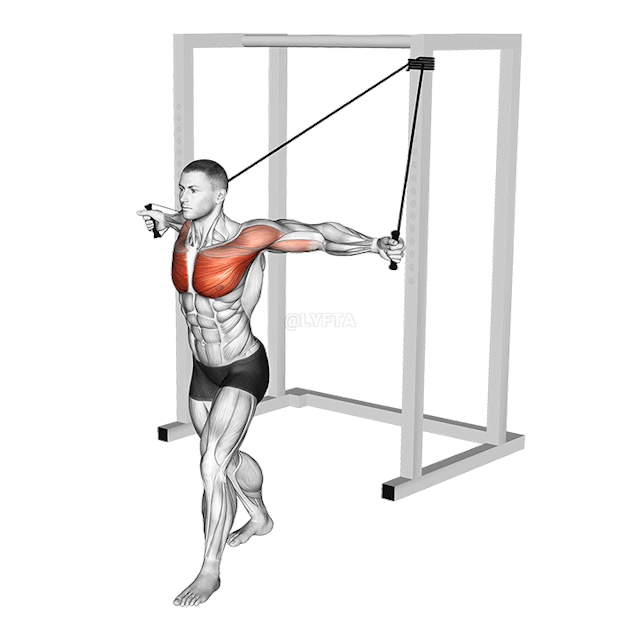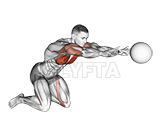
Band Low Chest Fly
Exercise Profile
Related Exercises:
Introduction to the Band Low Chest Fly
The Band Low Chest Fly is an effective upper body exercise that primarily targets the chest muscles, but also engages the shoulders and arms. This exercise is suitable for all fitness levels, from beginners to advanced, as the resistance can be easily adjusted. Individuals may want to incorporate this exercise into their routine to improve muscle tone, strength, and flexibility in the chest and upper body, and it can also aid in improving posture and balance.
Performing the: A Step-by-Step Tutorial Band Low Chest Fly
- Extend your arms to the sides at about chest level with your palms facing forward, ensuring there's tension in the band.
- Slowly bring your hands together in front of your chest in a controlled manner, keeping your arms almost straight and maintaining the tension in the band.
- Pause for a moment when your hands meet in the middle, squeezing your chest muscles.
- Gradually return your arms to the starting position, repeating the movement for the desired number of repetitions.
Tips for Performing Band Low Chest Fly
- Controlled Movement: The band low chest fly exercise is not about speed, but about controlled, smooth movements. Avoid the mistake of jerking or snapping the band. Instead, slowly and steadily pull the bands down and across your body. The control you maintain during the movement will help engage your chest muscles effectively.
- Correct Posture: Maintain a straight back and slightly bent knees throughout the exercise to avoid straining your lower back. A common mistake is to arch the back or lock the knees, which can cause injury.
- Full Range of Motion: Ensure you're using a full range of motion. This means fully extending your arms out to the
Band Low Chest Fly FAQs
Can beginners do the Band Low Chest Fly?
Yes, beginners can do the Band Low Chest Fly exercise. However, it's important to start with a lower resistance band to ensure proper form and prevent injury. As with any exercise, it's crucial to understand the correct technique. Beginners may want to have a trainer or experienced individual demonstrate the exercise first. Additionally, it's always a good idea to warm up before starting any exercise routine.
What are common variations of the Band Low Chest Fly?
- The Single-arm Band Low Chest Fly: This variation focuses on one side at a time, which can help address any muscle imbalances you might have.
- The Incline Band Low Chest Fly: This variation targets the upper chest muscles by performing the exercise on an incline bench or surface.
- The Decline Band Low Chest Fly: This variation targets the lower chest muscles by performing the exercise on a decline bench or surface.
- The Supine Band Low Chest Fly: This variation involves lying on your back on the floor or a bench, which can provide more stability and allow you to focus more on the chest muscles.
What are good complementing exercises for the Band Low Chest Fly?
- Push-ups are another great complementary exercise, as they work not only the chest muscles but also the triceps and shoulders, promoting overall upper body strength and stability which can enhance the effectiveness of the Band Low Chest Fly.
- The Incline Dumbbell Fly is a great addition to the Band Low Chest Fly, as it targets the upper pectoral muscles, providing a balanced chest workout and ensuring all areas of the chest are equally engaged.
Related keywords for Band Low Chest Fly
- Resistance Band Chest Fly
- Low Chest Fly Workout
- Band Chest Exercise
- Chest Strengthening with Band
- Resistance Band Low Fly
- Chest Workout with Band
- Lower Chest Exercise with Band
- Band-Assisted Chest Fly
- Home Workout Chest Fly with Band
- Resistance Band Fly for Chest.











